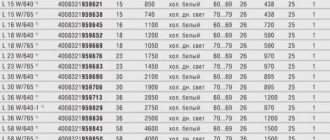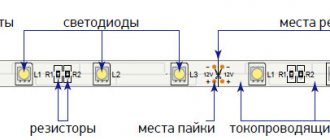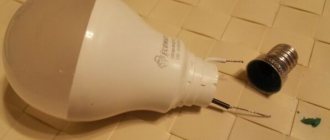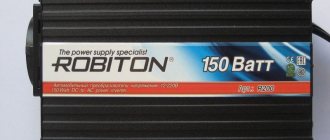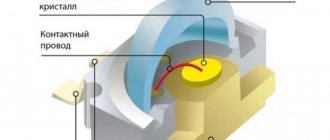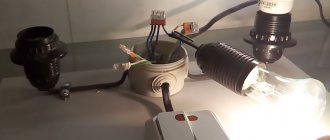- How does a dimmable lamp work?
- Types of dimmers for lamps
- What types of dimmable lamps are there?
- How to properly connect dimmable lamps
- Problems when using dimmable LED lamps
Dimmable lamps
is a light source whose brightness can be controlled using a special device. A dimmer is used to change the lighting intensity. Adjustment allows you to adjust the brightness in a room for a person based on his needs at the moment. For example, maximum brightness is suitable for reading, medium brightness is suitable for watching TV, and the minimum level is used as a night light.
All lamps with standard sockets - E27, E14, as well as lamps with a pin socket - GU5.3, GU10 are controllable.
Purpose and capabilities of the dimmer
Many people still don’t know what a dimmer and dimmable lamps are.
A dimmer is a device that allows you to regulate the light output of a lamp. The terms “dimmer, dimmer” are also used.
Dimmable lamps are light-emitting devices with variable luminous flux.
Rheostats have the ability to regulate the brightness of lamps, but they have significant weight and a lot of thermal energy is dissipated and lost on them.
Modern technologies make it possible to use dimmers designed on the basis of semiconductor elements - triacs or transistors.
The functions of dimmers include: smooth switching on and off of the lamp, timer, manual or automatic switching on of the flicker (blinking) mode, remote control of lighting intensity via wireless home Wi-Fi networks, remote control, voice or other acoustic signals, as well as a device controlled by a photocell that responds to the level of natural light in the room.
The use of dimming allows you to reduce energy consumption, extend the life of lighting fixtures by dimming the light, and fully relax after a busy day.
Types of dimmers for lamps
Most 220V dimmers are rheostatic; based on the control principle, they come in the following types:
- push-button
- control by pressing keys; - rotational
- the lighting level is adjusted by turning the knob; - touch
- switch by touching the touch screen; - with remote control
- control via a separate remote control or an application on a smartphone.
By installation type
dimmers are:
- invoices
- installed in the socket box; - modular
- fixed on a DIN rail; - built-in
- placed in an installation box or hidden under building elements; - wireless panels
- can be installed anywhere, because wireless technologies are used for control.
Using dimmers with LED lighting
The operation of dimmers is based on cutting off sections of the input sinusoidal voltage. So-called “cuts” are formed.
LED lamp power supplies (drivers) react negatively to changes in input voltage parameters and in some cases stop functioning normally.
How to choose a night light for the bedroom: tips and tricksLED lamps - which are better? Review of the most popular and reliable models, with photos and videos!
- How to choose a color temperature - see here! Table, instructions, overview of bright and optimal color temperature for the room
Features of the dimmer
Using a dimmer, you can regulate the intensity of lighting.
The simplest device for adjusting the intensity of lighting is a variable resistor or rheostat. A small electronic dimmer has become widespread. In this case, a semiconductor switch is used as a power element. The lighting intensity is adjusted by changing the voltage in the rheostat.
The dimmer is mainly made in the form of a switch, which allows it to be placed in a standard box. The lighting power is adjusted by rotating the handle. Dimming of LED lamps can also occur automatically. In this case, a sensor is installed in the room that measures the lighting level. A dimmable lamp reacts to any fluctuations by changing its intensity.
The main parameter of a dimmed unit is the output power. The number of LEDs that can be connected to the system depends on it.
Dimming problems with LED lamps
The operation of incandescent lamps when using a dimmer is not satisfactory. The same cannot be said about LED lamps, which either stop functioning or do not reach the rated light output and can produce an annoying squeaking sound.
To solve this problem, dimmable LED lighting products were created.How to make a dimmer with your own hands
To dim your light fixture to suit your specific personal requirements, you can create your own control unit. Relatively simple circuits are offered using triacs. But they cut off part of the leading edge, which creates problems when the load is inductive. The best result can be obtained using specialized microcircuits and pulse width modulation.
This figure shows a circuit diagram of an infrared remote control receiver (TSOP 1736). Inexpensive components are used here, so the total cost of all parts is low.
But we must take into account the total costs to understand the feasibility of such a project. The following should be added to the expenses:
- learning soldering skills;
- creation of an electrical circuit board, housing;
- purchase of consumables, tools, measuring instruments.
As a result, a handmade product sometimes turns out to be more expensive than a factory one.
How do dimmable lamps work?
Specially designed modified power supplies for these lamps vary the current in proportion to the input voltage.
It is noteworthy that the color flow temperature most often does not change when using dimmers.
Externally, it is impossible to distinguish between regular and dimmable LED lamps. You can distinguish them by the inscription “dimmable” or by the logo. Photos of various dimmable LED lamps can always be found on the Internet.
Connecting a lamp with your own hands - step-by-step instructions with photos and videos. Installation rules + connection diagramHow to choose office LED lamps - see the instructions here! Photos of ready-made solutions + electrician’s answers
- Choosing the best linear LED lamps: types, installation rules and tips for choosing LED lamps (130 photos)
Various technical solutions
Different dimmers are produced for 220V LED lamps. To make it easier to make your choice, you should pay attention to the advantages, capabilities and disadvantages of the following devices. They are grouped by control method:
- In mechanical dimmers, a rotating knob makes it easy to select the desired position. These devices are inexpensive.
- Push-button controls look more modern. A touch dimmer is sometimes equipped with a special screen that displays the light level and other technical parameters.
- It is convenient if adjustment is possible using a remote control. If the LED lamp and the control dimmer are connected via a radio channel, then use will be easier. The infrared analogue will have to be directed towards the receiver.
The dimmable LED lamp is well suited for completing automated systems. It is designed to withstand repeated activations without premature failure. To provide lighting control from anywhere where there is an Internet connection, use a controller with a Wi-Fi unit.
Operation of dimmable LED lamps
To use dimmable LED lighting devices, you need to select a lamp with the appropriate base, which should not cause difficulties.
There are dimmable lamps with different types and sizes of base.
Before purchasing, you should make sure which base, threaded or pin, and what diameter you need. Otherwise, a repeated visit to the store to exchange goods is inevitable.Interesting facts about dimmers
These devices comply with the CEI 23-86 / CEI EN 50428 HBES standard, which defines them as non-automatic control devices and associated accessories for use in electronic systems for the home and building.
There are 2 types namely TRIAC or IGBT where the first type called TRIAC reduces the power of the load while in case of having the acronym IGBT one can have more precise control of the load which can also be switched off if required. These systems can also be combined for shared use.
Risks when purchasing dimmable LED lamps
It is impossible to determine in advance whether the purchased dimmable lamp will work with the existing dimmer.
When purchasing LED dimmable lamps for your home, you should agree with the seller about the possibility of returning the purchased dimmable lamp with unsuitable parameters.
You should buy LED lamps made by reputable manufacturers, which, among other things, will increase the chances of matching the parameters of the lamp with the dimmer.
- Vertical blinds: features of the mechanism, pros and cons, photos of beautiful design
LED duralight - device, types, options and connection diagrams (130 photos + video)
- How to choose an energy-saving lamp for your home - types, characteristics and application features (105 photos)
Buying low-power lamps, less than 10 watts, will cost less, but you may be disappointed by the low luminous flux, insufficient adjustment range and unpleasant cold light.
Selecting a dimmable LED lamp yourself carries uncontrollable risks. To avoid them, you should consider consulting experienced professionals in a specialized shopping center and carefully study the accompanying documentation and technical features of the device.
With the relatively high price of dimmable LED lamps, one should not forget that their long service life and light output with low power consumption are incomparable with other light-emitting devices.
The use of such devices allows you to save on lighting in the future and is a profitable investment.
Product quality criteria
There is a lot of information on the packaging of each dimmable light bulb. To choose a functional product, you need to know what it all means.
Lamp shape and its effect on lighting
Dimmable lamps come in a wide variety of shapes, on which the degree of illumination depends.
By choosing the right LED device of a certain appearance, you will be able to achieve optimal lighting intensity. The following forms of lamps are available on the market:
- Pear-shaped. The flask has the same diameter as the body. These LEDs only shine forward. They are not recommended for installation in chandeliers whose shades are directed downwards. Pear-shaped LEDs will not be able to effectively illuminate the ceiling and shadows will appear on it.
- Resembling regular incandescent light bulbs. Used to implement traditional lighting. The angle of propagation of light fluxes is 240°.
- In the form of a candle or ball. This form was created primarily for decorative purposes. The lighting angle reaches 240-360°. The lamps combine well with open chandeliers, floor lamps, and sconces.
- Reflex type. Mainly used in shops and beauty salons. A special feature of the products is the creation of a targeted light beam that illuminates a specific area.
- Spot. Such products are installed in suspended or suspended ceilings, cabinet furniture to create additional or main lighting. They create a fairly large angle of light propagation - up to 100°.
Pear-shaped
Resembling an incandescent lamp Candle-shaped
Reflex type
Spot light lamp
To ensure that LEDs produce soft and uniform light, LED lamps are made of frosted glass. On the inside it has a special coating with different light transmittance. There are models with transparent glass on the market.
Flickering of light and methods for detecting it
Checking the flickering of a lamp with a pencil
This negative effect is typical for LED and fluorescent illuminators. Flickering light has a negative impact on a person’s well-being – the eyes get tired faster, and headaches are possible. If this defect is present, the LED cannot be used for residential premises. Flickering can be detected by the following signs:
- If you quickly look away from one object to another, you see double vision. This effect is called stroboscopic.
- You need to take a pencil by one end and move it like a pendulum. If clear outlines of the product are not visible, the flickering of the lamp is within normal limits. When there seem to be several pencils, the light pulsation is very high.
- You can use your smartphone to detect flicker. By turning on a regular camera and pointing it at a light source, you will be able to see the stripes. The brighter they are, the stronger the pulsation.
It is impossible to completely eliminate the flickering effect.
Dimming Level Limits
Most models can reduce light intensity by up to 10%. Some manufacturers produce LEDs, where this figure ranges from 5-25%. By combining lamps with different dimmers, it is possible to achieve the required level of lighting, which depends on the compatibility of the devices.
Power and operating voltage
Power is not a characteristic of the brightness of light - for this there is such an indicator as lumen.
It is indicated on the packaging of each product. LED products are available with power from 1 to 25 W. To evaluate the efficiency of devices, their luminous flux is compared with that generated by incandescent lamps. Their powers are related as 1 to 8-10.
When choosing a lamp, depending on the operating voltage, it is better to choose models where this indicator is 170-250 V. This will protect the device from burnout, which can happen when there is a current surge in the network.
Luminous flux and efficiency
A special feature of LED lamps is that their power does not always effectively reflect brightness. Therefore, the luminous flux is indicated on the product packaging. It ranges from 200-2500 lm.
A significant disadvantage of LEDs is the decrease in their efficiency during long-term operation. In the first 3000 hours of operation, the brightness of devices drops by 5%. Subsequently, the efficiency of the lamps decreases to 50% of the original value.
Colorful temperature
Light source color temperature scale
This indicator characterizes the color source in terms of spectral composition. Color temperature is measured in Kelvin. For workplace lighting, the optimal value is considered to be 4000-4500 K. For home use, it is recommended to take a lamp with a warm color of 2700-3500 K.
Color rendering index
An important indicator that reflects the correspondence of the color obtained under artificial lighting to its real shade. The higher the color rendering index, the more natural the objects in the room look.
Manufacturers produce lamps with a maximum value of 90 Ra.
Base and housing
Types of bases for energy-saving lamps
The most popular are LEDs with bases E27 and E14. They have a standard threaded connection. The E27 base is used for closed lamps, E14 – for sconces and floor lamps.
Technical characteristics of dimmable LED lamps
There are different types of dimmable LED lamps. The coating of the bulb can be matte or transparent, the brightness adjustment range is from 10 to 100%, the input voltage is from 40 to 250 V; as the brightness decreases, the color of the radiation can become warmer or remain unchanged.
Technologies from some manufacturers with a built-in ventilation system can extend the service life of dimmable LED lamps up to 40 thousand hours.
Benefits of using dimmable lamps
The use of dimmable lamps has several advantages:
- smooth adjustment of lighting brightness, which is convenient because it allows you to illuminate a room or a separate area of it, depending on the work being performed: watching TV, reading, etc.;
- using a dimmer with an LED lamp contributes to even greater savings on electricity;
- in the bedroom, the use of dimming allows you to avoid sudden switching on of light, which negatively affects the eyes;
- zoning of the premises. Instead of selecting lamps of different power, you can connect some of them to a dimmer and thus change the brightness of the lighting;
- reducing the flickering of LED lamps using a dimmer on a triac.
Important! You can combine a dimmer and a motion sensor. This will serve as security for the apartment and will automatically turn on and off the lights when the owners are not at home, creating the effect of presence.
Photo of a dimmable LED lamp?
Did you like the article? Share

1+
Luminous flux and efficiency
A dimmer for LED lamps, thanks to an electronic circuit, regulates the luminous flux.
The efficiency of a particular light bulb is determined by the luminous flux in lumens, which is indicated by the manufacturer on the packaging. Over time, however, LED lamps lose brightness and by the end of their service life their luminous flux is reduced by 50%.
| LED lamp power, Watt | Luminous flux, Lumen |
| 2-3 | 200 |
| 4-5 | 400 |
| 6-10 | 700 |
| 10-12 | 900 |
| 12-15 | 1200 |
| 18-20 | 1800 |
| 25-30 | 2500 |
LED lamps consume 4–8 times less energy than incandescent lamps for the same luminous flux. Using a dimmer allows you to increase this figure by 10 times.
What is color temperature
Color temperature is a measure of the spectrum in Kelvin. The indicator can be found on the packaging of the light bulb. The color temperature should be selected based on the situation for which it is intended. So, for work, it is better to select light bulbs that are as close as possible to daylight, that is, with a color temperature of 4000-5000 K. For the bedroom, warm light, conducive to relaxation, is well suited - 2700-3500 K; for the corridor, you can use cold light with a temperature of 5500 TO.
Color rendering index and its meaning
The index or color rendering coefficient is an indicator that characterizes the level of correspondence of the natural color of the body to the visible color when illuminated by a given source. The index shows how natural objects look when illuminated by a given source. So, the sun has a coefficient of 100 Ra. It is better to choose light bulbs for residential premises with an index value of 80 Ra, which is found in high-quality LED lamps. RGB LED strips used in interior design have a color rendering index of 20 Ra.
Light control problem
As noted above, every LED light bulb without dimming capabilities does not work correctly when the input voltage changes. In addition to flickering and the impossibility of fine tuning, the lamp simply will not turn on if the voltage does not match the specified level.
Dimming LED lamps involves changing the voltage sinusoid by separating part of the half-wave. The consequence of this is the appearance of “dead zones” that are incorrectly processed by the driver. As a result, the lamp responds to a lack of input mains voltage by operating incorrectly.
It should also be noted that there is a wide variety of electronic circuits for dimmers and drivers. Due to the lack of standardization, the problem of inconsistency arises. All devices are characterized by different minimum voltage response thresholds. If, when turned on, the dimmer gives 60 V, then the lamp will show only a third of the nominal value, and the control limits will fluctuate from 30 to 100%. With all this, for certain types of dimmable light sources the minimum brightness threshold is only 5%. As a result, the following problems may occur:
- The driver doesn't work.
- The driver emits an unpleasant sound at high frequencies.
- The maximum output voltage level in the dimmer is 210 V, which does not allow obtaining the maximum brightness indicator.
- Interruptions in the functioning of the dimmer due to incompatibility with the LED lamp circuit.
- A short (up to one second) flash when the device is turned on.
Note! The color temperature remains stable regardless of the brightness of the light.
Advantages of dimmable equipment over conventional equipment
If we compare these two types of LED lamps, then the first one can find many advantages with the only disadvantage - a slightly higher cost. Otherwise there are only positive qualities, including:
- Simple design and easy control.
- Saves up to 90% energy compared to a conventional LED lamp.
- Standard bases that do not require cartridge replacement.
- Dimmable LED ceiling lights are more durable by reducing the load on them.
- The ability to create an atmosphere that will be comfortable for the eyes.
- Change in temperature. If the light of the lamp is cold, then by turning the knob it will warm up a little.
You can learn a little more about them in the following video:
Types of lamps of this type
Recently, modular LED dimmable lamps have become widespread. They are used in offices, shopping pavilions or in houses and apartments. Their advantage is ease of placement. Such lighting fixtures allow you to arrange them in a row, connecting several pieces, or use each one as a separate element. They can be either built-in or hanging. There are special docking grooves for connecting devices.
When installing Armstrong-type ceiling lighting fixtures, office premises or retail pavilions are also noticeably transformed. These recessed LED dimmable lights are perfect for suspended ceilings and are a great alternative to the old fluorescent ones.
Base and body of the device
In everyday life, the most common bulbs with threaded sockets are E14 and E27.
E27 is used in conventional closed lamps, and with E14 - in sconces and open-type lamps.
The GX53 pin socket is used in light bulbs for recessed ceiling luminaires.
| Lamp type with screw base | Name |
| E26, E27 | ES – medium |
| E14 | SES – minion (small base) |
| E10, E12 | MES – miniature |
Bulbs with GU5.3, GU10 sockets are used in recessed spotlights.
New models of dimmable lamps have bases with ventilation ducts, which promote better heat removal from the inside of the lamp and diodes, thereby increasing their operating time.
Longer service life
The positive aspect and advantage of constantly operating LEDs in low light mode is that they increase their service life.
For example, if you initially take a light bulb that is twice as powerful as needed and turn it with a dimmer to the required brightness, then such a lamp will last 100% not only for the period stated by the factory, but also much longer.
But with halogen lamps the situation could be the opposite. In addition, darkening results in less heat generation.
Based on the above, experts always recommend buying dimmers and lamps for them in a store, with a visual check of the compatibility of their functions. In this case, you will 100% not have to face surprises and problems.

